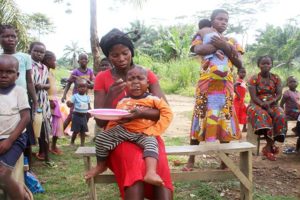Investing in healthy and diversified diets to address malnutrition in the Democratic Republic of the Congo
Deep in the equatorial forest of the Democratic Republic of the Congo, the Iyenze family grows fresh vegetables in their garden. Georgette, mother of eight, prepares porridge made from maize, soy, papaya and amaranth, for her children who suffer from malnutrition. Twice a week, Georgette goes…
 Deep in the equatorial forest of the Democratic Republic of the Congo, the Iyenze family grows fresh vegetables in their garden. Georgette, mother of eight, prepares porridge made from maize, soy, papaya and amaranth, for her children who suffer from malnutrition.
Deep in the equatorial forest of the Democratic Republic of the Congo, the Iyenze family grows fresh vegetables in their garden. Georgette, mother of eight, prepares porridge made from maize, soy, papaya and amaranth, for her children who suffer from malnutrition.
Twice a week, Georgette goes to the Tshudi health centre to participate in the cooking demonstration sessions organized by a local NGO, “Coeur de Compassion”, the centre’s medical team and FAO. She learns how to cook nutritious recipes made from local products.
Returning to the village
After having lived for three months in a forest camp due to intercommunal conflict, Georgette moved back to her village of Pelenge. When she returned, three of her eight children suffered from severe acute malnutrition. Poor sanitation and limited access to nutritious food had affected their health. “When we got back to the village, my two-year-old son, Bokila, was very weak. His arms, legs and face had swelled a lot”, says Georgette. “We were desperate and we didn’t know where to find help”, she added.
FAO’s project “Food security, information, nutrition and environment actions in Sankuru”, co-funded by the European Union and the Government of Belgium, is now supporting rural families in the region. As part of its activities, FAO, in partnership with the Territorial Inspectorate for Agriculture, Fisheries and Livestock, has implemented a community resilience and environmental protection project that aims to reduce the food insecurity and malnutrition of children under five and pregnant and lactating women in Sankuru.
Addressing child malnutrition
By 2018, more than 3.7 million children would suffer from acute malnutrition, of which 1.7 million are affected by severe acute malnutrition. The province of Sankuru is one of the most affected by chronic malnutrition with a prevalence greater than or equal to 45 percent for 15 years.
In order to effectively address malnutrition, the project relied on the support of the community in order to conduct home-based screenings of children. This is how Bokila was guided by the project’s nutritionist to the general hospital of Tshudi-Loto for medical care. When she left the hospital, Georgette joined a group of other mothers, to learn more about good nutritional practices and how best to incorporate these recipes into her family’s diet.
Nutritious meals
So far, the health centre has welcomed 220 children suffering from malnutrition in the Tshudi-Loto region. Thanks to nutrition training developed by FAO, 32 children have been cured. In addition, each household has received a vegetable kit (composed of a shovel, a rake, a watering can and 40 g of vegetable seeds) to cook the vegetables they’ve produced, thus improving the nutritional value of their meals.
“I am happy to participate in these cooking demonstration sessions. Before, we only ate wild meat and cassava flour”, explains Georgette. “Now I can cook different meals every day, and I can see the improvement in my children’s health”, she concludes.
Investing in nutrition-sensitive agriculture is essential in order to strengthen resilience in times of crisis for a healthy and prosperous future. By supporting children’s health from their first 1 000 days of life, FAO is sustainably strengthening the food security and nutrition of future generations.